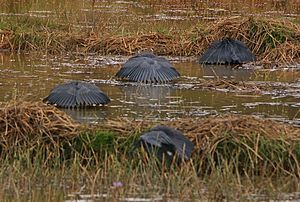Black heron facts for kids
Quick facts for kids Black heron |
|
|---|---|
 |
|
| Black heron canopy feeding | |
| Conservation status | |
| Scientific classification |
The black heron, also called the black egret, is a cool bird found in Africa. Its scientific name is Egretta ardesiaca. This heron is famous for how it hunts: it uses its wings like an umbrella to catch fish!
What Does a Black Heron Look Like?
The black heron is a medium-sized bird. It usually stands about 42 to 66 centimeters (16.5 to 26 inches) tall. These birds weigh around 0.27 to 0.39 kilograms (0.60 to 0.86 pounds).
They are easy to spot because of their completely black feathers. They also have a black beak and bright yellow feet. When it's time to breed, they grow long, fancy feathers on their head and neck.
Where Do Black Herons Live?
Black herons live in many parts of Sub-Saharan Africa. You can find them from countries like Senegal and Sudan all the way down to South Africa. They are most common in the eastern half of Africa and on the island of Madagascar. Sometimes, they have even been seen in Greece and Italy!
These birds love shallow, open water. They often hang out at the edges of freshwater lakes and ponds. You might also see them in marshes, along rivers, in rice fields, or in grasslands that flood during the rainy season. Near the coast, they can be found in tidal flats and along rivers where the tide comes in.
How Do Black Herons Hunt and Live?
The black heron has a super cool hunting trick called canopy feeding. It spreads its wings wide, forming a dark, umbrella-like shape over the water. This creates shade, which attracts small fish and makes them easier to see. This special hunting method was even shown on the BBC show The Life of Birds!
Sometimes, black herons hunt by themselves. Other times, they hunt in groups. You might see up to 50 herons feeding together, and sometimes even more! They usually hunt during the day, but they especially like to look for food around sunset. At night, they gather in groups to rest.
Their main food is small fish. But they also eat other things like water insects, crustaceans (like crabs), and small amphibians (like frogs).
When it's time to build a nest, black herons use twigs. They build their nests over water in trees, bushes, or reed beds. They start nesting when the rainy season begins. They often nest in colonies with other herons, and these colonies can have hundreds of birds! A female black heron usually lays two to four eggs, which are dark blue.




